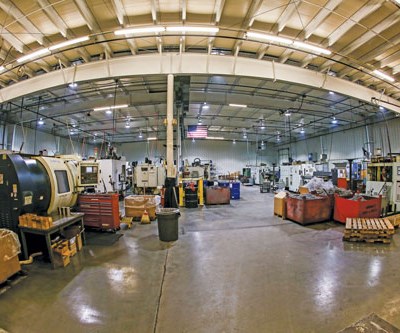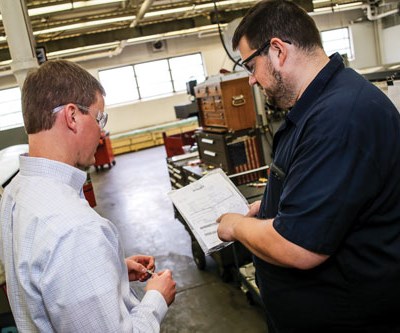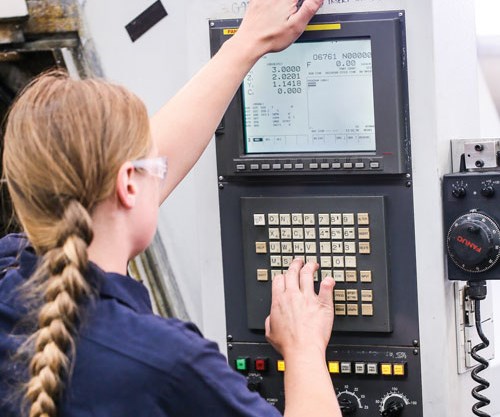Software Provides Time Savings and Improved Accuracy
Shops get paid for making chips, and profit comes from making them as efficiently as possible. Shop management software is a key to reducing waste by ensuring that machining is being done on the right jobs, in the right way and at the right time.
Many shops that were founded as screw machine production businesses find that the nature of that classification has changed, and in some cases, dramatically. Much of the bread and butter work that made high volume production of relatively simple parts has found homes elsewhere.
Nolte Precise Manufacturing has survived this transition. When the 60-person, Cincinnati, Ohio, based company was founded in 1916, it was a screw machine production house.
Today, Doug Coster, great-grandson of company founder Louis Nolte, is in charge of the company and oversees a different business than his great-grandfather knew. Like many shops that have survived the transition from cam actuated machine tools to CNC servo-driven machines, Nolte has managed to adapt to the changing demands of its customers and embrace the technology needed to meet those demands.
Traditional screw machine support functions, such as cam making, have morphed into CAD/CAM programming departments. This has led to a redefinition of screw machining and allowed a broadening of machining capabilities; G-code crosses many process boundaries.
CNC transitioning at Nolte has meant incorporating capabilities such as machining centers, turning, Swiss-type turning, multitasking turn-mill machines and component assembly to augment its screw machine base. The company still has some multi-spindle capability, but finding work and workers for these machines is increasingly difficult.
As the chip-making side of business has become more complex with additional process capability, managing it has also become more complex, especially dealing with a more diverse customer base in demanding industries from aerospace and automotive to medical, defense, energy, hydraulics, pneumatics and firearms. Having a broad machining capability and expertise is a good thing, which enables a shop to do more for its customer base, but managing what gets machined, how and when, becomes a scheduling problem. That’s why Nolte and many other shops rely on shop management software to help accurately, consistently and efficiently communicate between the shop floor and the front office.
Standardizing Risk
“In a job shop environment, whether a job is a first time or repeat, there are steps needed in the contract review process that must be done to mitigate risk to the shop,” Mr. Coster says. “Implementing a standardized suite of software modules helps ensure that communication flows smoothly and consistently to the relevant parties involved in manufacturing, inspecting and shipping the job. We get paid for making chips so streamlining all the front loading requirements helps us get to the chip making more efficiently and lowers our risk of errors.”
Since 1998, Nolte has relied on Shoptech’s E2 software for its quoting, order entry, shipping and accounting. These functions are modular, yet function under the E2 ERP umbrella. Interface standardization helps everyone in the company be familiar with the data they need to do their job while eliminating duplication of data. Everyone works from the same data set.
On incoming jobs, one of the E2 modules Nolte uses allows for inspection of the flow down requirements from the customer. This enables the company to match the certification requirements from the customer and include them on the work orders so the shop knows what it needs to do to meet those specifications.
The goal is to lower risk by communicating what is required before the first chip is cut. Moreover, these flow down specs are available to outside vendors such as material suppliers and tooling suppliers, so they are in the loop as well.
Who is Working on What
The E2 data collection module that Nolte uses has provided significant savings in both time and accuracy. It replaced a manual collection system that took days and hours to analyze with one that captures data in real time.
Mr. Coster says, “We first began using automated data collection when the shop was half the size it is now. Back then, we used time tickets that were manually generated and prone to errors. These tickets would be transcribed, and often employee numbers and job numbers would be entered or copied incorrectly. A lot of time was spent tracking down these errors, which delayed accurate job costing. We simply could not figure out how we were doing compared with our plan.
“Time clocks have been eliminated, so the employees log in on terminals located on the shop floor and enter the job assignment using bar codes. It has automated the data collection, and once it has been captured, there is no need to transcribe it again.”
He continues, “Human error has been eliminated, and we can perform real-time analysis of exactly what’s going on for costing purposes and compare that to scheduled work. In the 10 years since automating data collection, we have doubled our number of employees. I can’t imagine using the old, manual data collection system.”
Manufacturing Plan/Inspection Plan/Tool Path
While Nolte uses most of the modules that E2 has to offer, sometimes the complexity of manufacturing, especially in the industries served by Nolte, require more specialized software. Mr. Coster puts it this way. “It would be nice if there was a single software package that could do all the functions in a shop, from the manufacturing floor to front office, but that’s a tall order. Maybe someday there will be.”
In operation at Nolte, E2 functions as a more general router that describes how a part processes through the shop, and in doing so, creates the manufacturing plan for a given job. That is no small task when one considers, from that manufacturing plan, the software generates estimating, quoting, purchasing, shipping, job-costing, scheduling and accounting functions.
However, there are two areas where Nolte uses a different, more specialized software package. One is for toolpath generation for the company’s CNC machine tools, which is the CAD/CAM package from DP Technology’s Esprit software. Much of the manufacturing data generated from the CAM programing exercise is incorporated into E2 and becomes the manufacturing plan router that moves through the shop.
While the CAM software is used to generate toolpath programming and cycle time expectations for the machines, Nolte uses the system’s CAD capability to generate 3D models of the part to help with the quotation process. “Creating a part model to be manufactured in CAD helps us visualize its features and lower quotation risk by helping us more accurately make quotes,” Mr. Coster says. “Many of the areas where efficiencies can be realized can be identified before a chip is cut.”
The other software package Nolte uses complements its E2-generated manufacturing router by creating an inspection plan that travels with the router to the shop. It uses a software package from Discus that is especially designed for inspection. They are autonomous software systems, Mr. Coster says.
Discus’ software package allows Nolte to automatically match incoming customer prints to the shop’s quality plan. “Before we automated this function, Mr. Coster says, “I had an engineer manually balloon prints as they came in from the customer. He would fill in the numbers, get the inspection report, type the data into the inspection report, highlight what the features were, what the acceptance criteria were, how we were going to measure the first article and subsequent parts as needed. Discus allowed us to automate the entire process. And automatically generate PPAP and other inspection forms based on the inspection data requirements from the customer. That has been a big help for Nolte.”
Getting Started
The order entry process at Nolte has been simplified by the use of E2 shop management software. Step one is the use of a manual order entry process checklist.
A quote number is assigned, and the building steps for the part are identified. Risk analysis is performed prior to filling in the quote checklist, so basically entering the data into E2 requires confirming that what has been ordered matches what was quoted.
The quote number and manufacturing steps are then entered into the order entry module. Everything about quote resides in the software system once the data is entered. There is no redundant data entry needed.
Basically, the manufacturing plan is built in the quotation stage, so it need not be revisited. This creates a single point of access to the quote for the entire shop; eliminating duplication of the data. A single quote number accesses each job.
All of the functional teams, engineering, material planning, production planning, scheduling and fixturing/tooling have access to the data to perform their respective tasks. Nolte uses vendor-managed inventory for its consumables, and they manage the tooling inventory based on usage reports. Non-standard tool lists are generated in the Esprit program.
From this one order entry, the software tells the various functional teams when, where, and how much to buy for a given job. All the relevant data resides in a single data set and can be universally accessed by the various functional teams within the company.
A quote number becomes a part number once the job is manufactured and delivered. It is cross-linked by quote number, part number and print number to the same current information that resides in E2. Once, these files were kept manually with the risk of pulling the wrong job, and printing the wrong revision or quote. ERP has made the risk of that occurring non-existent, plus the time savings are significant.
Adding it All Up
Before taking over the business from his father, Mr. Coster worked in the accounting field and is a CPA. He especially likes the integrated accounting module that is part of the E2 system.
Each of the software modules within E2 accumulate accounting data that automatically compares estimated cost with actual costs in terms of time and materials. “When we get an invoice,” Mr. Coster says, “the software uses a three-level checking system that alerts us if we paid too much. I enjoy accounting, but manually inputting the data is not for me. The E2 system does this automatically from quote through shipping. It also expedites closing the monthly books and helping us determine how we’ve done from a P&L perspective.”
Implementing ERP
While the software has a metalworking pedigree, it still takes some effort to match unique shop practices to a software system. “Not being large enough to have custom software developed for us,” Mr. Coster says, “we had to do significant modification to how we internally operated to accommodate E2. It took some time, but eventually, what were changes to our procedures have become standard operating procedures. It has been worth the effort.”
Related Content
Deacom Essentials ERP Software Helps Digitally Transform SMBs
Deacom Essentials gives manufacturers a cost-effective, tailored ERP software solution to gain better insights into operations in order to make informed decisions and scale their overall business.
Read MorePrecision Machining Technology Review: August 2024
Production Machining’s August 2024 technology showcase includes some of the latest technology from SW North America, Tsugami, Siemens, Select Manufacturing Technologies, Hurco and ECI Software Solutions — all on display at IMTS 2024.
Read MoreERP Software Enables Manufacturers to Maximize Operational Efficiencies
PMTS 2023: JobBoss2 from ECI Software Solutions assists manufacturers with decision-making and reveals opportunities for growth and cost savings.
Read MorePrecision Machining Technology Review October 2023
Production Machining’s October 2023 technology showcase includes some of the latest technology from Tungaloy-NTK America Inc., Renishaw, Walter USA, Seco Tools and Haimer USA.
Read MoreRead Next
Emerging Leaders Nominations Now Open
Here’s your chance to highlight a young person in your manufacturing business who is on the path to be a future leader moving your company forward.
Read More5 Aspects of PMTS I Appreciate
The three-day edition of the 2025 Precision Machining Technology Show kicks off at the start of April. I’ll be there, and here are some reasons why.
Read MoreA Tooling Workshop Worth a Visit
Marubeni Citizen-Cincom’s tooling and accessory workshop offers a chance to learn more about ancillary devices that can boost machining efficiency and capability.
Read More



























